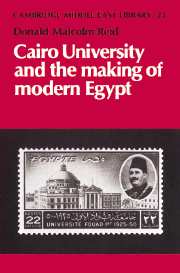Book contents
- Frontmatter
- Contents
- List of illustrations
- List of tables
- Acknowledgments
- Note on academic terminology and transliteration
- List of abbreviations
- Introduction
- Part I The private university, 1908–1919
- Part II The university and the liberal ideal, 1919–1950
- 4 The transition to a state university
- 5 Rival imperialisms and Egyptianization
- 6 Issues of equity: a university for whom?
- 7 The university and politics, 1930–1950
- 8 The issue of religion
- Part III In Nasser's shadow, 1950–1967
- Part IV The university since Nasser
- Conclusion and prospect
- Notes
- Select bibliography
- Index
4 - The transition to a state university
Published online by Cambridge University Press: 30 October 2009
- Frontmatter
- Contents
- List of illustrations
- List of tables
- Acknowledgments
- Note on academic terminology and transliteration
- List of abbreviations
- Introduction
- Part I The private university, 1908–1919
- Part II The university and the liberal ideal, 1919–1950
- 4 The transition to a state university
- 5 Rival imperialisms and Egyptianization
- 6 Issues of equity: a university for whom?
- 7 The university and politics, 1930–1950
- 8 The issue of religion
- Part III In Nasser's shadow, 1950–1967
- Part IV The university since Nasser
- Conclusion and prospect
- Notes
- Select bibliography
- Index
Summary
The Renaissance prince and the Wafdist tribune
When Prince Fuad abandoned the Egyptian University to its fate in 1913, few would have believed it would survive or that its ex-rector would one day be king. But Fuad knew how to scheme and how to wait. Sultan Husayn Kamil died in 1917, his son declined the throne, and the British judged Fuad innocuous enough to reign. In 1925 — the year Muhammad Reza became shah, Mustafa Kemal [Atatürk] banned the fez and turban, and uprisings challenged France in Syria and the Moroccan Rif — King Fuad refounded the Egyptian University as a state institution.
To his regret, the king had to share the limelight, both at the university and in national politics. High Commissioner Viscount Edmund Allenby spoke for a weakened England which still dreamed imperial dreams. Unlike many Englishmen, the conqueror of Jerusalem was realist enough to see that England must loosen the reins and seek Egyptian allies in order to preserve her vital interests. Saad Zaghlul emerged as Egypt's tribune, reaching out beyond his own upper class to all his countrymen and boldly calling for immediate independence. Lutfi al-Sayyid, the first rector of the state university, spoke as one of the intellectuals and wealthy landowners who broke with Zaghlul to form the Liberal Constitutionalist Party.
- Type
- Chapter
- Information
- Cairo University and the Making of Modern Egypt , pp. 71 - 86Publisher: Cambridge University PressPrint publication year: 1990



